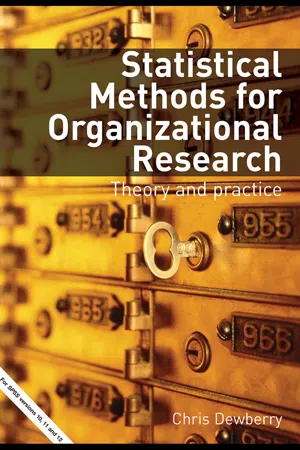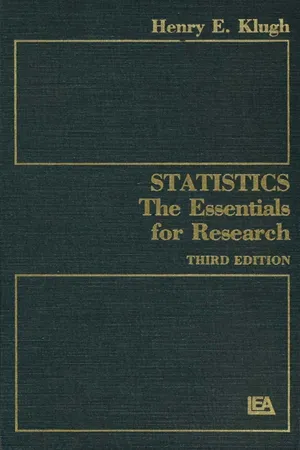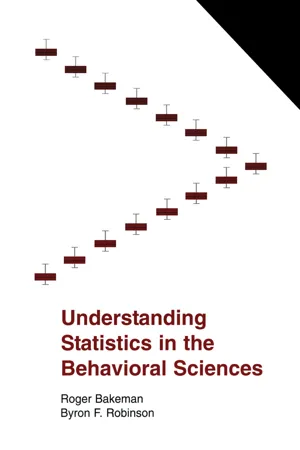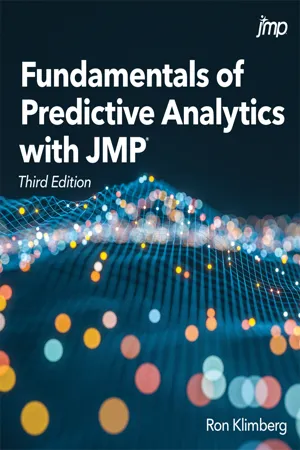Psychology
Z-Score
A Z-score in psychology is a statistical measure that indicates how many standard deviations a data point is from the mean of a group of data. It is used to compare and interpret individual scores within a distribution, allowing psychologists to understand the relative position of a particular score and make meaningful comparisons across different measures and populations.
Written by Perlego with AI-assistance
Related key terms
Related key terms
1 of 4
Related key terms
1 of 3
10 Key excerpts on "Z-Score"
- eBook - ePub
- Marion Marshall(Author)
- 2019(Publication Date)
- Routledge(Publisher)
Figure 3.2 and note that 50 + 34 = 84%. To use another example, a Z-Score of –1.0 would translate to the 16th percentile rank (50 – 34 = 16).More than likely, the test maker will not use these Z-Scores but will have converted them to “standard scores” with a different scale, like the SAT does. Given the earlier SAT example, the 600 score would be generated from a +1.0 Z-Score. Suffice it to say that this can seem confusing if every test uses a different scale though many use a scale similar to cognitive (IQ) tests, which have a mean of 100 and an SD of 15. It is interesting to note that “Standard” scores are not really standard. The reason is the word, as it is used here, refers to “standardizing” the scores, not that they all use the same scale. In fact, the definition of “standard score” is what is called the Z-Score here. This is why using percentile ranks can help you with comparing results across tests and most readers are used to thinking about and comparing results using percentile ranks. While the “standard score” scales may vary, the percentiles can be compared directly. Just be clear when explaining the assessment results to parents to clarify the difference between percentile rank and percentage correct . See Chapter 6 to learn how to explain tests results to parents and avoid this potential misunderstanding, and see Wright and Darr Wright (2016) for a detailed, carefully constructed and “parent friendly” explanation of the psychometrics of assessment scores is on: www.wrightslaw.com/advoc/articles/tests_measurements.htmlRemember that, while you need to know how the scores are derived, you will not be required to calculate them. The scores will be accessed in a table in the examiner’s manual or, if the test scoring is computer-based, from the data file in the computer. They will be accurate if you are using a well-constructed and technically reliable instrument, have computed the chronological age correctly, and have calculated the raw scores (or composite scores based on the raw scores) accurately. What matters is that you understand what the scores mean. - eBook - ePub
Statistical Methods for Organizational Research
Theory and Practice
- Chris Dewberry(Author)
- 2004(Publication Date)
- Routledge(Publisher)
z score is exactly the one that we have been using. That is,where x is the score obtained by a particular case, is the mean of all the cases, and SD is the standard deviation of all the cases. When a z score is positive it tells us the number of standard deviation units that a score falls above the mean, and when it is negative it tells us the number of standard deviation units that a score falls below the mean.Z SCORES AND THE NORMAL DISTRIBUTION
Armed with our knowledge of what z scores are, we are now in a position to draw together all of the things discussed so far in this chapter. We have agreed that if we draw a line through a normal distribution we can work out the proportion of people (or objects) with scores the same or less than those on that line. We also agreed that we can also work out the proportion with scores greater than those on the line. Now, in the normal distribution, z scores dictate the position of these vertical lines. A z score of 0 is always in the centre of the distribution, a z score one standard deviation above the mean is always in the position shown in Figure 3.6 , and one drawn two standard deviations below the mean is always in the position shown in Figure 3.7 .Because we can work out the percentage of a distribution that lies above (or below) a vertical line drawn through the distribution, it follows that we can position a line any number of z scores (i.e. standard deviation units) we like from the mean, and work out the percentage of the distribution with scores equal to, or less than, that point. So we can work out the percentage of cases with z scores equal to or less than 1.00, the percentage with z scores equal to, or less than, -1.36, and the percentage equal to or less than any other number of z score units. Using some complex algebra, this is exactly what statisticians have done, and the results of their labour can be seen in Tables 3.1 and 3.2 . Table 3.1 - Robert Warner(Author)
- 2015(Publication Date)
- Elsevier(Publisher)
P values conforms to well-established statistical principles. The resulting uniformity of interpretation, as well as the demonstrable soundness of conclusions based on the use of Z scores improves the reliability of the data analysis. As will be shown below, it is easy to produce displays of Z scores that permit the review of large amounts of data both accurately and efficiently. This helps relieve the tedium and fatigue often associated with the review of large collections of data.• Permit a Choice of Multiple Standards of Comparison – As discussed, Z scores are calculated using the mean and SD that have been calculated for a particular set of data. An additional advantage of Z scores is that there are several different possible choices for the set of data used to calculate this mean and SD:• Comparison of the Data Points to the Mean of the Same Set of Data – In this case, the Z scores of each data point in a set of data are calculated using the mean and SD of the same set of data to which the data points belong. For example, the admissions committee of a university may want to choose from their pool of applicants the ones whose scores on a standardized college admissions test are significantly better than those of the others in the same group of applicants. The committee would then calculate the Z score of each applicant’s test score, using the mean and SD of the test scores of the same group to which the applicant belongs.• Comparison to a Known Normal Standard – One can also calculate a Z score for each member of a data set whose normal versus abnormal status is unknown by using the mean and SD of a separate set of data that has been established by independent criteria to be normal. Any statistically significant Z score that is calculated in this way is significantly different from an established normal standard, rather than from the mean of the set of data from which the data point came. For example, a medical laboratory may have collected test data from a group of patients who are known by independent criteria not to have particular diseases. It then uses the mean and SD from that group of nondiseased patients to calculate Z scores for the patients whose status with respect to that disease is unknown. Each patient whose Z score for this parameter is both directionally appropriate and statistically significant when calculated in this way can be said to meet this diagnostic criterion for the disease [2 ,3- eBook - ePub
Statistics
The Essentials for Research
- Henry E. Klugh(Author)
- 2013(Publication Date)
- Psychology Press(Publisher)
Figure 4.3 seems to extend only from −3σ to +3σ, the theoretical normal distribution extends an infinite distance on either side of the mean. For all practical purposes however, we can permit the curve to intersect the abscissa once we have passed ±3σ; only 26 measures in 10,000 will fall beyond these limits.The characteristics described above will only be exactly true for distributions which are exactly normal, and we rarely find exactly normal distributions of real data. However, most distributions of psychological measures are approximately normal, close enough so that we can usually expect the characteristics of normal distributions to apply.4.6 Standard ScoresIt is often helpful to transform raw scores into scores based on standard deviation units. These are called standard scores. One kind of commonly used standard score is called a z score. A z score is the deviation of a raw score from the mean of its distribution divided by the standard deviation of that distribution. Thus, a score which falls exactly one standard deviation above the mean of its distribution is equivalent to a z score of 1.00; if it falls one standard deviation below the mean it is equivalent to a z score of −1.00. The formula for z scores isFormula 4.6 z scoresIf a normal distribution has μ = 46 and σ = 8, a raw score of 54 will be equivalent to z = 1.00; it will be one standard deviation above the mean. This z score is at the 84th centile, a result we can deduce from Figure 4.3 . Note that 50 percent of the curve falls below μ, a fact immediately apparent because μ, divides the symmetrical curve in half; an additional 34 percent falls between μ and +1σ. Therefore, 84 percent must fall below +1σ. For any approximately normal distribution we can expect to find about 84 percent of the measures falling below z = 1.00.Continuing with the same distribution and Formula 4.6, we find a raw score of 38, one standard deviation below the mean, is equivalent to z = − 1.00. From the percentages marked off in Figure 4.3 , it can be seen that z = -1.00 falls at the 16th centile. Thus X = 38 is at the 16th centile. Similarly, from Formula 4.6, X = 62 is equivalent to z = 2.00, and Figure 4.3 - eBook - ePub
Understanding Political Science Statistics
Observations and Expectations in Political Analysis
- Peter Galderisi(Author)
- 2015(Publication Date)
- Routledge(Publisher)
Z-Score and is represented by the following equation:where xiis the observed value for any individual case (i)X̅ is the mean of all the values in the distribution that contains xisxis the standard deviation of all of the individual values in that distributionThe Z-score standardizes any particular value, in our example income, in relation to the distribution of which it is a part. That distribution is defined by both its mean (X̅) and its standard deviation (sx). Let us say that we find from census figures that the standard deviation of incomes for my neighborhood was $20,000, and $1,000 for my parents’ neighborhood. Let’s calculate the Z-score for each of us, father and son, respectively:Z-scores convert absolute deviations (how many dollars above or below the mean is our income?) to standardized ones (how many standard deviations above or below the mean is our income?). My parents earned 2 standard deviations above the mean of their neighborhood. We earned only 1 standard deviation above the mean of ours. We were therefore relatively worse off (i.e., relatively worse off for our local comparison group) than my parents were at the same point in their lives, even if our purchasing power was greater.Z-Score A measure of deviation from the mean standardized by the standard deviation of a distribution when the mean is 0 and the standard deviation is 1.Before we move on to a more precise interpretation of these values, one important point needs to be made. Notice that when we computed Z-scores the unit of measurement ($) drops out. This allows us to make standardized relative judgments about incomes across time (1973 dollars vs. 2006 dollars) and across cultures (dollars vs. euros or pesos). Again remember that these are comparisons of relative worth, not absolute purchasing power. To figure out the latter, we would need to turn to inflation charts and currency converters. As we will see when we discuss regression (Chapter 11 ), standardized scores also allow us to make comparisons between distributions measuring entirely different properties (e.g., education [measured in years] and income [measured in dollars]). Z-scores have no differential unit of measurement. The units are measured as standard deviations and are therefore universally - eBook - ePub
- Debbie L. Hahs-Vaughn(Author)
- 2020(Publication Date)
- Routledge(Publisher)
z scores are then computed as follows:z cognitive ability== 1.0( 75 − 60 )15z motivation== − 1.0( 60 − 70 )10The conclusion for the third example is that performance is better on the cognitive ability assessment; that is, you scored one standard deviation above the mean for the cognitive ability assessment and one standard deviation below the mean for the motivation index. These examples serve to illustrate a few of the many possibilities, depending on the particular combinations of raw score, mean, and standard deviation for each variable.Let us conclude this section by mentioning the major characteristics of z scores. The first characteristic is that z scores provide us with comparable distributions , as we just saw in the previous examples. Second, z scores take into account the entire distribution of raw scores . All raw scores can be converted to z scores such that every raw score will have a corresponding z score. Third, we can evaluate an individual’s performance relative to the scores in the distribution . For example, saying that an individual’s score is one standard deviation above the mean is a measure of relative performance. This implies that approximately 84% of the scores will fall below the performance of that individual. Finally, negative values (i.e., below 0) and decimal values (e.g., z = 1.55) are obviously possible (and will most certainly occur) with z scores. On the average, about one-half of the z scores for any distribution will be negative and some decimal values are quite likely. This last characteristic is bothersome to some individuals and has led to the development of other types of standard scores, as described in the next section.4.2.2 Other Types of Standard ScoresOver the years, other standard scores besides z scores have been developed, either to alleviate the concern over negative and/or decimal values associated with z scores or to obtain a particular mean and standard deviation. Let us examine some common examples. The first additional standard score is known as the T score and is used in tests such as most behavior rating scales, as previously mentioned. TheT scoreshave a mean of 50 and a standard deviation of 10. A second additional standard score is known as the IQ score - Roger Bakeman, Byron F. Robinson(Authors)
- 2005(Publication Date)
- Psychology Press(Publisher)
Y score for the ith subject is:(5.8)Z i = Y i-M YSD YEquation 5.8 is expressed in terms of sample statistics. The corresponding definition expressed in terms of population parameters is:(5.9)Z i = σY i- μNote that both the deviation (Yi -My or Y- μ) and the standard deviation (SDy or σ) are measured in the units used for the initial scores. Thus when one is divided by the other, the units cancel, resulting in a unit-free score, neither lies nor inches. Actually, because deviation scores are divided by the appropriate standard deviation, we can regard the resulting standard scores as being expressed in standard deviation units. A standard score of 1.0, then, means the corresponding raw score is exactly one standard deviation above its mean, whereas a standard score of -1.0 indicates a raw score one standard deviation below the mean, a standard score of 2.5 implies a raw score two and a half standard deviations above the mean, and so forth.Exercise 5.6 Standard Scores This exercise modifies the current spreadsheet so that, in addition to the mean, variance, and standard deviation, it now computes standard scores as well.General Instructions
- Add two columns to the current spreadsheet. In the first column enter formulas for Z scores and in the second column enter formulas for the square of the Z scores.
- Enter formulas for the sum, count, and mean of the Z scores. Enter formulas for the sum, count, mean, and square root of the mean for the squared Z score. What is the mean Z score? Why must it be zero? What is the variance and standard deviation for the Z
- Ron Klimberg(Author)
- 2023(Publication Date)
- SAS Institute(Publisher)
z -score as follows:Z ==x − μσ= 7570 − 50010The z -score (and the t -score) is not just a number. The z -score is how many standard deviations away that a value, like the 570, is from the mean of 500. The z -score can provide you some guidance, regardless of the shape of the distribution. A z -score greater than (absolute value) 3 is considered an outlier and highly unlikely. In the example, if the new marketing campaign is as effective as suggested, the likelihood of increasing monthly sales by 7 standard deviations is extremely low.On the other hand, what if you calculated the standard deviation and it was $50 million? The z -score is now 1.4 standard deviations. As you might expect, this can occur. Depending on how much you like the new advertising campaign, you would believe it could occur. So the number $570 million can be far away, or it could be close to the mean of $500 million. It depends on the spread of the data, which is measured by the standard deviation.In general, the z -score is like a traffic light. If it is greater than the absolute value of 3 (denoted |3|), the light is red; this is an extreme value. If the z -score is between |1.65| and |3|, the light is yellow; this value is borderline. If the z -score is less than |1.65|, the light is green, and the value is just considered random variation. (The cutpoints of 3 and 1.65 might vary slightly depending on the situation.)Fundamental Concept 4This concept is where most students become lost in their first statistics class. They complete their statistics course thinking every distribution is normal or bell-shaped, but that is not true. However, if the FC1 assumption is not violated and the central limit theorem holds, then something called the sampling distribution of the sample means will be bell-shaped. And this sampling distribution is used for inferential statistics; that is, it is applied in constructing confidence intervals and performing hypothesis tests.- John M. Spores(Author)
- 2023(Publication Date)
- Routledge(Publisher)
μ, pronounced “myoo” for a population mean); (c) its areas or proportions are divided by uniform standard deviation units, which are precisely known and tabulated; and (d) it can be efficiently depicted in graphic form (see below). It is extremely convenient because it allows psychologists to convert personality test raw scores into such uniform units in order to determine their precise locations in the distribution (i.e., how extreme and in what direction).The standard normal distribution is portrayed in Figure 6.1 .Figure 6.1 The Normal Distribution Partitioned by Standard Deviation Units from the MeanNote: μ = Greek symbol mu (pronounced “myoo”) for the population mean. σ = Greek symbol for the population standard deviation. Percentages (per empirical rule): (a) about 68% of scores fall between –1 and +1 standard deviations from the mean; (b) about 95% of scores fall between –2 and +2 standard deviations from the mean; and (c) about 99% of scores fall between –3 and +3 standard deviations from the mean. Interpretation: scores falling outside of –2 and +2 standard deviations from the mean are generally considered statistically rare and atypical; when measuring the presence of psychological symptoms, those falling greater than +2 standard deviations are often considered to be indicative of genuine psychopathology.It has several extremely useful features for purposes of psychological measurement. First, the most frequent score is a standard deviation of “0” (i.e., no deviation), which represents the mean or central tendency average score. Second, the frequencies decrease gradually at the same rate below and above the standard deviation of “0” score. This indicates that identical percentages of scores fall between the same standard deviation values above and below the central point. This aspect also gives the curve its normal or perfectly symmetrical inverted U-shaped appearance.7- Martin Lee Abbott(Author)
- 2014(Publication Date)
- Wiley(Publisher)
z -score data and the descriptive information about the distribution. First, we should use the information we have to estimate what a solution might be.What can we observe generally? Certainly, because z scores are expressed in standard deviation units on the standard normal distribution, the student probably did not perform highly on the test (i.e., because negative scores are on the left of the distribution—in this case more than 1.5 SDs to the left of the mean). Consider the following formula, which is derived from the z -score formula listed above:In this formula, the z score we need to transform to a raw score (X ) is known, along with the SD and mean of the raw score distribution. Substituting the values we listed above, we obtainSo, we can inform the student’s mother that her child received 75.40 on the test. Although we don’t know how that might translate into a teacher’s grade, it probably has more meaning to a parent who does not normally see z scores. To the researcher, however, the z score contains more information.TRANSFORMING CUMULATIVE PROPORTIONS TO z SCORES
Another situation may arise in which we have cumulative proportions or percentiles available and wish to transform them to z scores. This is a fairly easy step because both are based on z scores.In our previous example, the student’s inquisitive mother would probably have been given a percentile rather than a z score because the educational system uses percentiles extensively as the means to make comparisons among scores. Here is a brief example, again using the mother. Suppose the student’s mother was told that her son received a score that was at the 60th percentile. What would be the z
Index pages curate the most relevant extracts from our library of academic textbooks. They’ve been created using an in-house natural language model (NLM), each adding context and meaning to key research topics.
Explore more topic indexes
Explore more topic indexes
1 of 6
Explore more topic indexes
1 of 4









